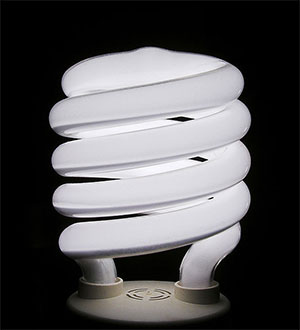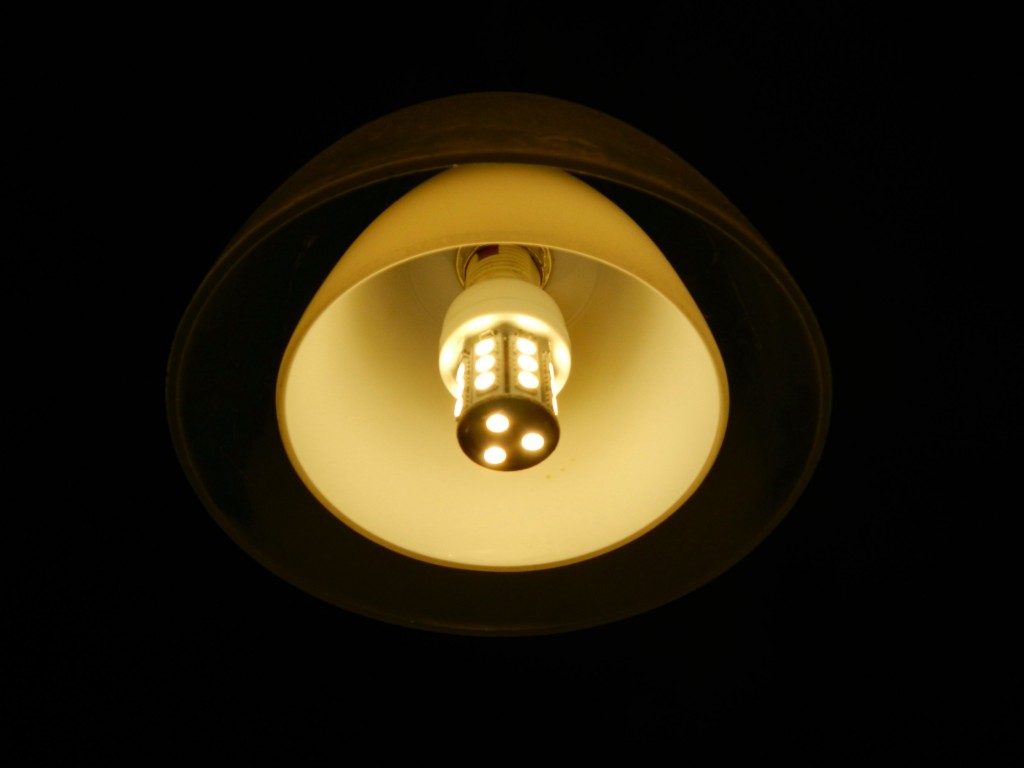Small sins add up – what’s the right light bulb?

Compact fluorescent bulb. Photo: Reisio, CC some rights reserved
Last month I was helping someone move. There was a decision to be made on a burned-out compact fluorescent light bulb. I felt beset by all there was to accomplish and (o, the shame!) it ended up in the trash.
I can trot out a small list of justifications. But the bottom line is: that was not the correct thing to do. There’s mercury in those puppies and they need to be disposed of so that doesn’t contaminate the world at large.
Obviously, I feel guilty – as I should. I made a mental note to at least learn where the bulbs can go and make an organized space in our house to set them aside and dispose of them correctly. (Just as we already do for dead batteries.)
That guilt and resolve is why this CBC article caught my eye “Home Depot quietly ends light-bulb-recycling program“.
I gather my local remaining disposal options include Canadian Tire, Rona and Ikea. All good to know. But…possibly not at all locations. And according to the City’s own “special items” disposal information, Ikea (not unreasonably) does not want bulbs not sold by them. (Should this be the retailer’s burden in the first place?)
Here’s my point: I am trying to get this right, and it’s a hassel.
Let’s face it, this type of patch-work disposal, which demands both research and special effort, is bound to produce compliance issues.
Change is coming – or is already here – on sales of conventional incandescent bulbs. They’ll no longer be sold as of 2014 in Canada. In the U.S. the game-shifter is something called the Energy Independence and Security Act (EISA) of 2007. Technically, it’s not a ban. It’s a gradual phase-out of light bulbs that can’t meet required energy efficiency standards. According to this Sept. 2012 article in Computer World:
In the U.S., EISA standard requirement for 100-watt bulbs began last January. The ban on 75-watt bulbs goes into effect Jan. 1, 2013.
The deadline for the most popular bulbs, the 60-watt and 40-watt lamps, is Jan. 1, 2014.
Incandescent bulb technology is an energy hog. By and large, it cannot meet the targets. Which is why/how those bulbs will end up off the shelves. The law can’t stop consumers from using incandescent bulbs, a fact that has led to hoarding for those who prefer the light they grew up with.
Forcing a shift was intended to save energy, of course. And it will do that that. (At the cost of rankling those who feel the market and consumers should make those choices without “nanny state” intervention.) But the disposal issue really needs more attention.
This January article in the Globe and Mail “Canada unprepared for flood of mercury light bulbs“ says the problem goes beyond diverting the light bulbs from landfills. According to information in a report commissioned by Environment Canada, the Globe article states “The Aug. 31 study also found no national or industry-wide standards for the handling of mercury waste”. Furthermore,
The study, which surveyed some 28 of the 123 places that store or manage mercury waste, also found Canada lacks any facility to extract pure mercury from waste, relying instead on mercury distillers in the United States.
The authors warn that with growing restrictions on trans-border movements of mercury, such as a U.S. ban on pure mercury exports effective Jan. 1 this year, Canada may need to resolve pending storage issues.
OK. Sounds like Canada has some homework to do on the light bulb and mercury file. Is it any better in the U.S.?
My husband has a sort of geeky interest in the light bulb scene. He’s been saying all along that the CFL bulbs are going to be a problem and the switch has not been well-considered. He thinks LED bulbs are the future. But LEDs have issues too, including higher expense, at present. Trent Hamm of “The Simple Dollar” put together an extensive comparison of the pros/cons and costs of incandescent, CFL and LED lighting. Here is his bottom line:
Clearly, given the current market conditions, CFLs are the best bargain at the moment for our home lighting needs. However, they have drawbacks – they have special disposal requirements and do not provide immediate illumination as incandescent bulbs and LED bulbs provide.
However, if you’re avoiding CFLs and are directly switching to LEDs from incandescent bulbs, replacement LED bulbs are already there in terms of cost. You’ll have to judge for yourself if the light quality matches your needs.
We just switched to some LEDs in our kitchen. I’m still deciding if I like them or not. They come on at full brightness right away, which I really appreciate. But should you happen to look at them dead on they are almost blinding.
Someday, I hope for something as nice as the instant, warm light of incandescents – which also saves energy and avoids mercury pollution. It doesn’t look like we’re there quite yet!
What are you doing for light in your house? How do you dispose of old bulbs?
Tags: canada, energy, environment, light bulbs, mercury pollution









I stopped buying incandescent bulbs about six years ago…well, almost stopped, I still buy them for job-site work lights because we break them as fast as we can buy them. At home though, we went CFLs , buying a case and using them to replace dead bulbs one by one. There are still a few incandescent bulbs in the basement, and I will not throw out a working bulb. The CFLs have been great, and very few have needed disposing yet…and no, I have no idea where they’re supposed to go, and no one seems to care.
Recently, I purchased my first LED bulbs, and I like them. The CFLs in my kitchen seem to have grown dimmer with age, and a couple of LED bulbs have made enough difference that I’ll probably tolerate the dim ones until they die. The LEDs are expensive, and I know that a lot of people won’t have the attention span necessary to appreciate the savings, but they may be the answer to the mercury problem, especially for those still hooked on incandescents.
I have a mix. For instance in a 3 bulb fixture two are cfls. But the annoying thing is they are not lasting as long as the packging suggests. CFLs and other fluorescents are fine when left on steadily but as with all lightbulbs the on and off action is what kills them. None have lasted two years. NYSERDA person at the state fair said the energy star bulbs will last. That is what she has been told. It doesn’t prove in my experience.
The hazardous nature of mercury is a problem and like the rechargable batteries from phones, I have to save them and take them somewhere special out of town-that is annoying. Like ink cartridges, taking stuff 25 miles away to a town I visit maybe every other month gets forgotten.
Used oil has a home. To your question, should retails be responsible for these bulbs? The answer is sure. The same truck that delivers bulbs can carry dead ones back.
I must admit I find this subject comical. We now know these cfl’s cause skin cancer and contain mercury. We are trying to cut down on the amount of energy drawn on a antiquated, overloaded energy grid so that the amount of mercury(and other pollutants) produced by coal burning electric power plants is reduced. In effect, we are bringing the contaminate directly into our living environment, contained or not… I have broken so many light bulbs in my lifetime, it is impossible to imagine the number, take a look at recommended action to be followed,when these bulbs are broken. At the same time, this administration is pumping millions of taxpayer dollars into electric cars(no one wants) that must be charged off the same power grid. The amount of energy saved with these bulbs is minuscule, the amount these cars will draw is astronomical.
Here’s another thought. We are now totally dependent upon China, Inc. for our day to day lighting. Last I knew there were no cfl’s manufactured here (too expensive to comply with those pesky worker safety regulations). Manufacturing of these hazardous, worthless curlicues is affecting the health of those kids working in the sweat shops over there so that we can save a very little bit of power (we certainly aren’t saving any money; the bloody things don’t last as long as a 130 volt incandescent). Sort of reminds one of the ethenol boondoggle…….
Candles, anyone?
Jokes aside…in a strange way, I’m relieved by this conversation. All of you have raised the issues and aggravations (and, Lucy, the guilt) that I’ve grappled with since the introduction of CFLs. I was hoping someone had cut a clear path through the problem. Sometimes, our decisions about research and technology baffle me: while there is probably no perfect solution, it’s frustrating that we haven’t made more progress…creating a better light bulb (i.e., energy efficient, safe, long-lasting, etc.) should be right up there with curing the common cold.
I have some tubular style CFL’s which have lasted over a decade. They were pretty expensive at the time but I think they were actually made in the USA. Some of the cheap newer helical style bulbs have failed within as little as a few days which I chalk up to manufacturing flaws. After a bad run I started to buy only reputable brands and if possible bulbs made in first world manufacturing facilities. Those seem to hold up much better.
Cycling on and off is a problem with these bulbs and will lead to premature failure. Forget what your dad or grandpa told you – leave the light on when you leave the room if you are gong to come back in a reasonable amount of time, like maybe 15 minutes or so. The bulbs are much more efficient so you wont be wasting so much electricity but you will be saving bulb life.
CFL’s do have a drop off in light output over time. So if you haven’t already switched it might be worth skipping the technology and going straight to LED. Much greater efficiency and supposedly much longer life. Not enough time to fully understand the drawbacks beyond price. And price is dropping rapidly.